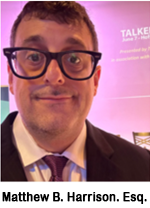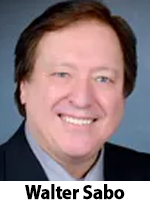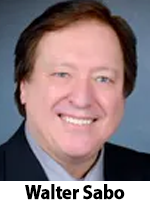SABO SEZ: Managing the Meters is a Fatal Time Waster
By Walter Sabo
a.k.a. Walter Sterling, Host
WPHT, Philadelphia, “Walter Sterling Every Damn Night”
and TMN syndicated, “Sterling on Sunday”
 At first, I thought it was a joke. When I realized there were serious people having serious meetings about the joke, it became both horrific and symptomatic
At first, I thought it was a joke. When I realized there were serious people having serious meetings about the joke, it became both horrific and symptomatic
The sitcom is called: MANAGING THE METERS. Note: As a suited consultant I was a prime mover to get Arbitron off diaries and onto meters.
Worldly success is often the result of being highly focused on what one can control versus imagining what can be controlled. Nielsen can manage their meters. You can’t.
Imagining what can be controlled has led to wasting time playing MANAGING THE METERS. To participate one must learn where Nielsen meters are placed, which station has which meters, and who is carrying “your” meters. Yes, one can learn, for example, that a 19-year-old in Glendale listens to KIIS-FM for 17 hours a week. More than 17 hours in radio conference rooms will be spent playing whack-a-mole with that 19-year-old’s meter; where will it land next?
Playing MANAGING THE METERS is a major time waster and cume killer. Once upon a time many music stations embraced “request line call-in research.” Shudder. Stations would tally which songs were getting how-many requests and make on-air playlists based on those counts. Obviously call-in request playlists would appeal primarily to existing listeners and do nothing to reach new listeners. Sure, P1s are appeased but cume always dies.
And here we are: Super-serving meter holders who already listen to a station will appease P1s but cume will diminish every month. It is pure myth that “talk” is high TSL and low cume. In fact, most current talking stations do everything possible to lower cume. Casual cuming is virtually impossible. (Who is talking? What’s the number? Thanks for holding on! Who has time to hold on?). The MANAGING THE METERS fantasy gives “science” to cume-killing actions and reactions.
MANAGING THE METERS, rather than making better, bigger shows has resulted in fear, indecision, and the crime of overthinking. Nothing could be worse for a medium that thrives on emotional wallops than turning feelings into math.
What to do when tempted to play MANAGING THE METERS:
— Go for a pleasant walk and imagine a better show, new promotions, fresh promos and surprising, possibly weird topics.
— Eat your favorite ice cream and imagine a better show, new promotions, fresh promos and surprising, possibly weird topics.
— Call your father and thank him and imagine a better show, new promotions, fresh promos and surprising, possibly weird topics.
— Remember that innovative programmers who CREATE – rather than copy – great stations give all of their attention to P2s and then imagine a better show, new promotions, fresh promos and surprising, possibly weird topics.
Walter Sabo has been a C Suite action partner for companies such as SiriusXM, Hearst, Press Broadcasting, Gannett, RKO General and many other leading media outlets. His company HITVIEWS, in 2007, was the first to identify and monetize video influencers.. His nightly show “Walter Sterling Every Damn Night” is heard on WPHT, Philadelphia. His syndicated show, “Sterling On Sunday,” from Talk Media Network, airs 10:00 pm-1:00 am ET, and is now in its 10th year of success. He can be reached by email at sabowalter@gmail.com.



 In the golden age of broadcasting, the rules were clear. If you edited the message, you owned the consequences. That was the tradeoff for editorial control. But today’s digital platforms – YouTube, X, TikTok, Instagram – have rewritten that deal. Broadcasters and those who operate within the FCC regulatory framework are paying the price.
In the golden age of broadcasting, the rules were clear. If you edited the message, you owned the consequences. That was the tradeoff for editorial control. But today’s digital platforms – YouTube, X, TikTok, Instagram – have rewritten that deal. Broadcasters and those who operate within the FCC regulatory framework are paying the price. This coming Sunday, June 15, is Father’s Day. For that day – and the Friday before (hint-hint) – you might have already readied Harry Chapin’s “
This coming Sunday, June 15, is Father’s Day. For that day – and the Friday before (hint-hint) – you might have already readied Harry Chapin’s “
 When Georgia-based nationally syndicated radio personality, and Second Amendment advocate Mark Walters (longtime host of “Armed American Radio”) learned that ChatGPT had falsely claimed he was involved in a criminal embezzlement scheme, he did what few in the media world have dared to do. Walters stood up when others were silent, and took on an incredibly powerful tech company, one of the biggest in the world, in a court of law.
When Georgia-based nationally syndicated radio personality, and Second Amendment advocate Mark Walters (longtime host of “Armed American Radio”) learned that ChatGPT had falsely claimed he was involved in a criminal embezzlement scheme, he did what few in the media world have dared to do. Walters stood up when others were silent, and took on an incredibly powerful tech company, one of the biggest in the world, in a court of law. “Fewer than half of Americans plan to travel this Summer,” according to a
“Fewer than half of Americans plan to travel this Summer,” according to a  Dozens of brand-new audio hardware and software companies have been launched during the past 20 years. These start-ups are usually funded by venture capital money. VC money is not invested to return a profit, it’s poured in to – pour it in. Their money is “different” than the cashflow that fuels your business. Start-up money buys time to profit.
Dozens of brand-new audio hardware and software companies have been launched during the past 20 years. These start-ups are usually funded by venture capital money. VC money is not invested to return a profit, it’s poured in to – pour it in. Their money is “different” than the cashflow that fuels your business. Start-up money buys time to profit. In a ruling that should catch the attention of every talk host and media creator dabbling in AI, a Georgia court has dismissed “Armed American Radio” syndicated host Mark Walters’ defamation lawsuit against OpenAI. The case revolved around a disturbing but increasingly common glitch: a chatbot “hallucinating” canonically false but believable information.
In a ruling that should catch the attention of every talk host and media creator dabbling in AI, a Georgia court has dismissed “Armed American Radio” syndicated host Mark Walters’ defamation lawsuit against OpenAI. The case revolved around a disturbing but increasingly common glitch: a chatbot “hallucinating” canonically false but believable information. TALKERS publisher Michael Harrison introduced the term in the 1990s, inviting us to think-beyond the real-time audio we were sending up those towers. What he described seemed conceptual, even futuristic, back then, when we were still logging-onto AOL via dial-up (screech).
TALKERS publisher Michael Harrison introduced the term in the 1990s, inviting us to think-beyond the real-time audio we were sending up those towers. What he described seemed conceptual, even futuristic, back then, when we were still logging-onto AOL via dial-up (screech). Right now, dozens of well-suited, over-priced, unpleasant lawyers are fighting in Hollywood over the title credit their client should receive on a movie, TV show, or book cover. Placement within the credit roll at the end of a show is a battleground of egos and legalities. Part of the process of securing proper credit is governed by multiple union rules negotiated by multiple unions and corporate dictates of corporate masters. (You don’t get to be CEO of Paramount by being a nice guy.)
Right now, dozens of well-suited, over-priced, unpleasant lawyers are fighting in Hollywood over the title credit their client should receive on a movie, TV show, or book cover. Placement within the credit roll at the end of a show is a battleground of egos and legalities. Part of the process of securing proper credit is governed by multiple union rules negotiated by multiple unions and corporate dictates of corporate masters. (You don’t get to be CEO of Paramount by being a nice guy.) Music radio’s competitors were vinyl, then tape, then CDs – before smartphone streaming and satellite radio offered more portability and variety. And before consolidation, broadcasters were under less of the revenue pressure that now commercializes many stations beyond listeners’ tolerance.
Music radio’s competitors were vinyl, then tape, then CDs – before smartphone streaming and satellite radio offered more portability and variety. And before consolidation, broadcasters were under less of the revenue pressure that now commercializes many stations beyond listeners’ tolerance.  “It won’t work on FM.” Country. Country was predicted to be a failing format for the FM band. At the dawn of FM proliferation in the 1970s, the future of the band was viewed with fear and skepticism. Why wouldn’t country music work on the FM band? The conventional chatter said that “country needs to be on AM because truckers drive long distances and AM signals cover long distances. FM does not.”
“It won’t work on FM.” Country. Country was predicted to be a failing format for the FM band. At the dawn of FM proliferation in the 1970s, the future of the band was viewed with fear and skepticism. Why wouldn’t country music work on the FM band? The conventional chatter said that “country needs to be on AM because truckers drive long distances and AM signals cover long distances. FM does not.” When a blogger found “no biography, or further information about the woman who is supposedly presenting this show,” it forced Australian Radio Network to
When a blogger found “no biography, or further information about the woman who is supposedly presenting this show,” it forced Australian Radio Network to  These books have helped me tell stories, prioritize programming initiatives and manage career strategies. If interested in a book the link connects to its page on Amazon.
These books have helped me tell stories, prioritize programming initiatives and manage career strategies. If interested in a book the link connects to its page on Amazon. These conventions used to be about making-the-most-of those towers behind radio stations that played in several rooms at home and occupied two knobs and six buttons in the dashboard. Back to the future…
These conventions used to be about making-the-most-of those towers behind radio stations that played in several rooms at home and occupied two knobs and six buttons in the dashboard. Back to the future… Serious business coaches reveal that a common trait of successful people is their ability to immediately forget their failures and to move on. Next idea. Next project. Surrounded by seas of committees, forms, rules and mediocrity, effective leaders know that just trying something, regardless of the outcome, is the WIN.
Serious business coaches reveal that a common trait of successful people is their ability to immediately forget their failures and to move on. Next idea. Next project. Surrounded by seas of committees, forms, rules and mediocrity, effective leaders know that just trying something, regardless of the outcome, is the WIN.  Hello from Las Vegas, ever-changing yet timeless. Here this week the NAB Show is “Powering the Next Era of Storytelling.” And it’s about time. While there is now a filibuster-proof U.S. Senate majority to require that cars include AM receivers, some AM stations are being shut off. Over the weekend millions took to the streets and this morning Wall Street braced for more. So, the vibe here is positively rejuvenating.
Hello from Las Vegas, ever-changing yet timeless. Here this week the NAB Show is “Powering the Next Era of Storytelling.” And it’s about time. While there is now a filibuster-proof U.S. Senate majority to require that cars include AM receivers, some AM stations are being shut off. Over the weekend millions took to the streets and this morning Wall Street braced for more. So, the vibe here is positively rejuvenating. Corporate cost cuts continue. In
Corporate cost cuts continue. In  Thank you, TALKERS for placing me on two panels at the IBSNYC conference. All student conferences have one underlying goal: Attendees want to know how to land a starter job in media. Here’s the information I shared with the eager crowd.
Thank you, TALKERS for placing me on two panels at the IBSNYC conference. All student conferences have one underlying goal: Attendees want to know how to land a starter job in media. Here’s the information I shared with the eager crowd. There has never been more news. And news has never been more quotable. It costs two-plus cents to make a penny.
There has never been more news. And news has never been more quotable. It costs two-plus cents to make a penny. Thank you, TALKERS for having me on panels at the TALKERS Generations 2025 IBSNYC conference this past Saturday (3/8). Moderator and Philadelphia talk show god Dom Giordano asked us the inevitable: “What is the future of radio?”
Thank you, TALKERS for having me on panels at the TALKERS Generations 2025 IBSNYC conference this past Saturday (3/8). Moderator and Philadelphia talk show god Dom Giordano asked us the inevitable: “What is the future of radio?” Observation, as a heavy CNBC viewer: Artificial Intelligence is to 2025 what Dot Com was to the late 1990s, game-changer… and shiny object.
Observation, as a heavy CNBC viewer: Artificial Intelligence is to 2025 what Dot Com was to the late 1990s, game-changer… and shiny object. During my tenure at NBC, once a month the division heads would meet at the behest of the CEO to report on their progress and trends in their sector. As the executive vice president of the FM division, I took a seat in that formidable group and tried to keep my remarks as brief as possible. What could I possibly say that would be more damn important than the words of the president of NBC News or the NBC Television network? In addition to NBC’s CEO, the CEO of owner RCA would often join the fun.
During my tenure at NBC, once a month the division heads would meet at the behest of the CEO to report on their progress and trends in their sector. As the executive vice president of the FM division, I took a seat in that formidable group and tried to keep my remarks as brief as possible. What could I possibly say that would be more damn important than the words of the president of NBC News or the NBC Television network? In addition to NBC’s CEO, the CEO of owner RCA would often join the fun. Radio is an intimate, one-to-one medium; so “you” and “your” – speaking to one person – will resonate more than addressing “all of you.” There’s only one of me.
Radio is an intimate, one-to-one medium; so “you” and “your” – speaking to one person – will resonate more than addressing “all of you.” There’s only one of me. Jim Gearhart is a remarkable on-air talent who was the AM drive host on New Jerey 101.5 for 20-plus years. In the 1960’s he was a star on WCBS-AM and WNEW. The illustration is an ad for his 2:00 pm to 4:00 pm show on WNBC circa 1968.
Jim Gearhart is a remarkable on-air talent who was the AM drive host on New Jerey 101.5 for 20-plus years. In the 1960’s he was a star on WCBS-AM and WNEW. The illustration is an ad for his 2:00 pm to 4:00 pm show on WNBC circa 1968.
